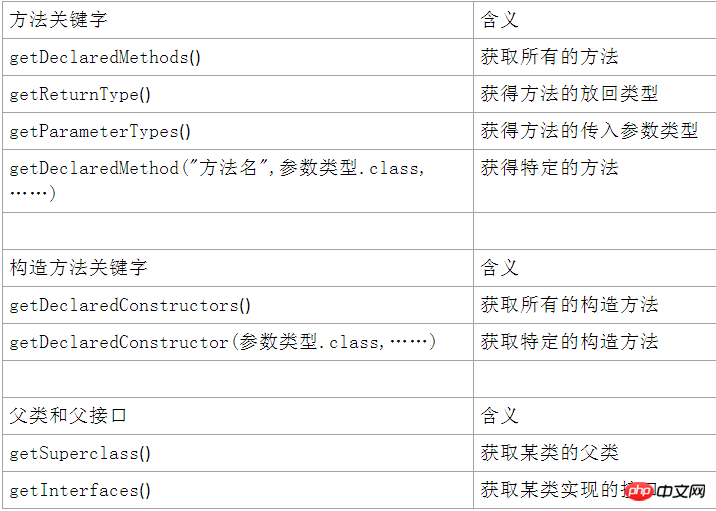
This article mainly introduces relevant information about the reflection mechanism in Java. Friends who need it can refer to
Detailed explanation of the reflection mechanism in Java
Reflection , I often heard them say that I had read some information and may have used it in Design Pattern, but I didn’t feel I had a deep understanding of it. I studied it again this time and it felt okay. Bar!
First, let’s take a look at the concept of reflection:
Mainly refers to the ability of a program to access, detect and modify its own status or behavior, and can The status and results of its own behavior, adjusting or modifying the status and related semantics of the behavior described by the application.
Reflection is a powerful tool in Java that allows us to easily create flexible code that can be assembled at runtime without source code linking between components. But improper use of reflection can be very costly!
If you are confused by the concept, continue reading.
2. The role of the reflection mechanism:
1, decompilation: .class-->.java
2, accessed through the reflection mechanism Properties, methods, Construction methods, etc. of java objects;
This seems to be easier to understand. Let’s look at how to implement these functions in detail.
Third, let’s take a look at the classes in the reflection mechanism that sun provides us with:
java.lang.Class; java.lang.reflect.Constructor; java.lang.reflect.Field; java.lang.reflect.Method; java.lang.reflect.Modifier;
We can operate many methods, properties, etc. in reflection from Query within these four categories. Or should we learn to constantly query the API, that is our best teacher.
Four, specific function implementation:
1, the reflection mechanism has three methods to obtain the class, let’s get the Employee type
//第一种方式:
Classc1 = Class.forName("Employee");
//第二种方式:
//java中每个类型都有class 属性.
Classc2 = Employee.class;
//第三种方式:
//java语言中任何一个java对象都有getClass 方法
Employeee = new Employee();
Classc3 = e.getClass(); //c3是运行时类 (e的运行时类是Employee)2, Create object: After getting the class, we create its object, use newInstance:
Class c =Class.forName("Employee");
//创建此Class 对象所表示的类的一个新实例
Objecto = c.newInstance(); //调用了Employee的无参数构造方法.3, get attributes: divided into all attributes and specified attributes:
a, Let’s first look at how to get all the attributes:
//获取整个类
Class c = Class.forName("java.lang.Integer");
//获取所有的属性?
Field[] fs = c.getDeclaredFields();
//定义可变长的字符串,用来存储属性
StringBuffer sb = new StringBuffer();
//通过追加的方法,将每个属性拼接到此字符串中
//最外边的public定义
sb.append(Modifier.toString(c.getModifiers()) + " class " + c.getSimpleName() +"{\n");
//里边的每一个属性
for(Field field:fs){
sb.append("\t");//空格
sb.append(Modifier.toString(field.getModifiers())+" ");//获得属性的修饰符,例如public,static等等
sb.append(field.getType().getSimpleName() + " ");//属性的类型的名字
sb.append(field.getName()+";\n");//属性的名字+回车
}
sb.append("}");
System.out.println(sb);b. Get specific attributes. Compare with the traditional method to learn:
public static void main(String[] args) throws Exception{
<span style="white-space:pre"> </span>//以前的方式:
/*
User u = new User();
u.age = 12; //set
System.out.println(u.age); //get
*/
//获取类
Class c = Class.forName("User");
//获取id属性
Field idF = c.getDeclaredField("id");
//实例化这个类赋给o
Object o = c.newInstance();
//打破封装
idF.setAccessible(true); //使用反射机制可以打破封装性,导致了java对象的属性不安全。
//给o对象的id属性赋值"110"
idF.set(o, "110"); //set
//get
System.out.println(idF.get(o));
}4. Get the method and construction method. No more details. Description, just look at the keywords:

In this way we can obtain various contents of the class and decompile it. For a language like JAVA that compiles first and then runs, the reflection mechanism can make the code more flexible and easier to implementObject-oriented.
Fifth, reflection plus Configuration file makes our program more flexible:
In the design pattern learning, when learning the abstract factory Reflection was used to more conveniently read database connection strings, etc. I didn’t quite understand it at the time, so I just copied it. Take a look at the use of reflection + configuration files in .NET:
The configuration file used at that time was the app.config file, the content was in XML format, and the content of the linked database was filled in:
<configuration>
<appSettings>
<add key="" value=""/>
</appSettings>
</configuration>How to write reflection:
assembly.load("当前程序集的名称").CreateInstance("当前命名空间名称".要实例化的类名);The advantage of this is that it is very easy for us to change the database. For example, if we upgrade the system database from SQL Server to Oracle, then we write two D layers and change the content of the configuration file. Just click or add conditions to select, which brings great convenience.
Of course, the same is true in JAVA, except that the configuration file here is .properties, which is called a properties file. Read the contents through reflection. In this way, the code is fixed, but we can change the content of the configuration file, which makes our code much more flexible!
To sum up, learning JAVA reflection again and using it flexibly can make our code more flexible, but it also has its shortcomings, that is, using it will reduce the performance and complexity of our software. increase, so we need to use it carefully.
The above is the detailed content of Detailed explanation of reflection mechanism examples in Java. For more information, please follow other related articles on the PHP Chinese website!




